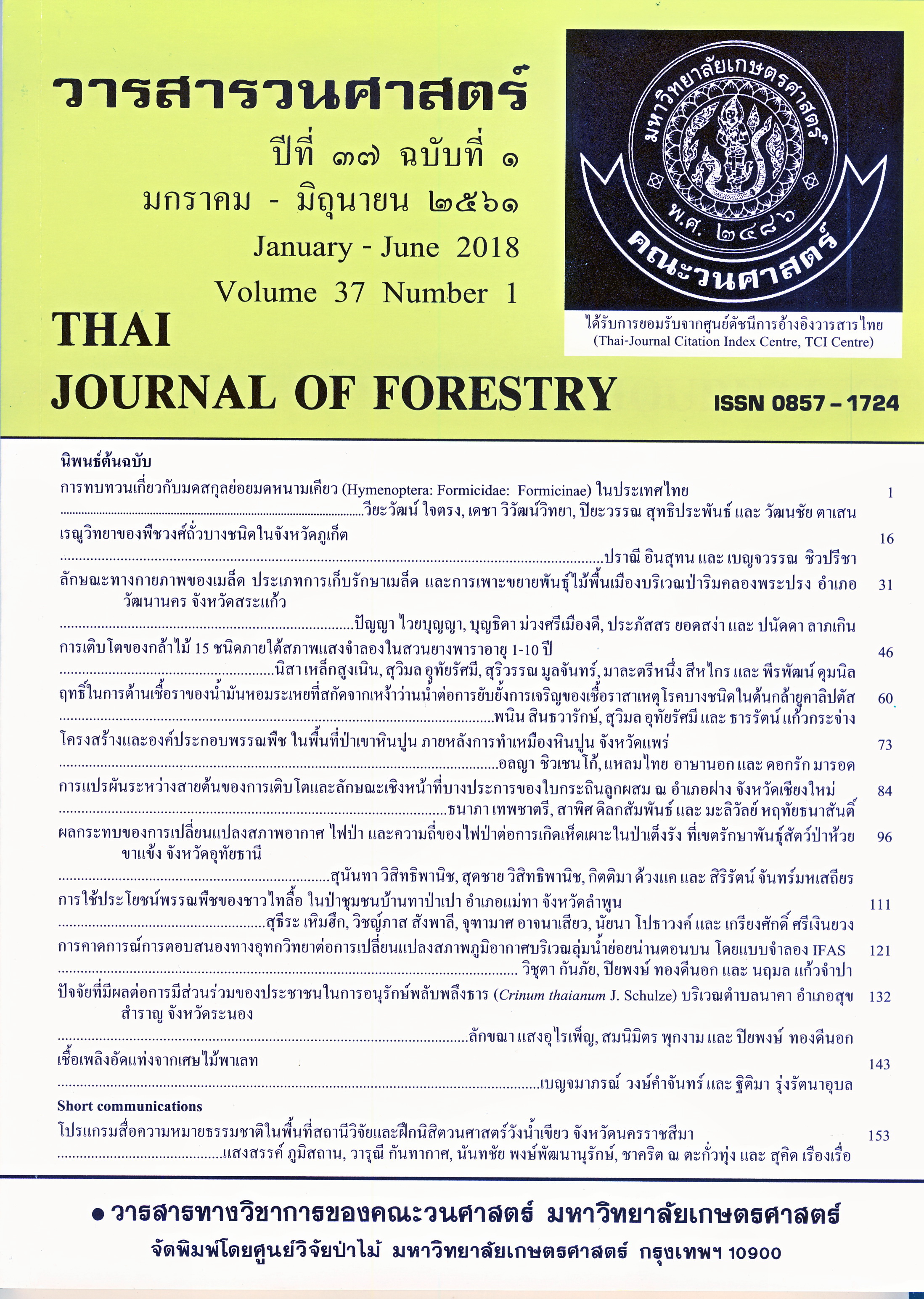การเติบโตของกล้าไม้ 15 ชนิดภายใต้สภาพแสงจำลองในสวนยางพาราอายุ 1-10 ปี
Main Article Content
บทคัดย่อ
ยางพาราเป็นพืชชนิดหนึ่งที่นิยมปลูกเพิ่มขึ้นทดแทนการปลูกข้าวโพดในพื้นที่ภาคเหนือของประเทศไทย แต่จากการปลูกแบบเชิงเดี่ยวบนพื้นที่สูงและลาดชันก่อให้เกิดปัญหาด้านการพังทลายของหน้าดินในฤดูฝน ดังนั้นการปลูกพืชชนิดอื่นร่วมกับยางพาราจึงเป็นอีกทางที่ช่วยอนุรักษ์ดินและน้ำ เนื่องจากพืชแต่ละชนิดมีระบบรากหลากหลายเมื่อปลูกร่วมอยู่ในสวนยางพาราก็จะทำให้อัตราการพังทลายของดินและการไหลบ่าหน้าดินของน้ำลดลงด้วย การศึกษาครั้งนี้จึงมีวัตถุประสงค์เพื่อศึกษากล้าไม้ของพรรณพืช 15 ชนิดที่มีรายงานว่าทนร่ม และมีคุณค่าทางเศรษฐกิจ รวมถึงสามารถปรับตัวกับสภาพแวดล้อมทางภาคเหนือได้ โดยทำการศึกษาการเติบโตสัมพัทธ์ทางด้านเส้นผ่านศูนย์กลาง ความสูง และจำนวนใบ โดยจำลองสภาพแสงภายในสวนยางพาราอายุ 1, 2, 3, 4, 5–7 และ 8–10 ปี ที่มีปริมาณความเข้มแสงอยู่ร้อยละ 100, 80, 60, 40, 20 และ 10 ของความเข้มแสงบนเรือนยอดตามลำดับ ในโรงเรือนคณะวนศาสตร์ มหาวิทยาลัยเกษตรศาสตร์ เป็นระยะเวลา 1 ปี
อัตราการเติบโตสัมพัทธ์ของพืชส่วนใหญ่ลดลงตามปริมาณแสงที่ลดลง (ตามอายุยางพาราที่เพิ่มขึ้น) ชนิดที่มีการเติบโตสัมพัทธ์โดยรวมสูงสุด ได้แก่ ข่า ชะพลู สัก และรองลงมาได้แก่ มะม่วง มะแขว่น กาแฟ เตย และหวาย ส่วนชนิดที่มีการเติบโตสัมพัทธ์ต่ำที่สุดได้แก่ ลิงลาว เหลียง และมะตูมแขก เมื่อยางพารามีอายุ 1–3 ปี (ระดับแสงร้อยละ 100–60) นั้นสามารถปลูกพืชได้ทั้ง 15 ชนิดที่กล่าวมาและรวมถึงพืชอื่นๆ เนื่องจากแสงในระดับนี้ไม่ส่งผลกระทบต่อการเติบโตของพืช แต่เมื่อยางพาราอายุมากกว่า 3 ปี พืชที่ทนร่มเป็นชนิดที่แนะนำให้ปลูกในพื้นที่ โดยจากการศึกษาครั้งนี้แนะนำให้ปลูกเตย ข่า ชะพลู พะยูง มะแขว่น และสัก ซึ่งควรปลูกผสมกันไปเนื่องจากเตย ข่า และชะพลูเป็นพืชที่ให้ผลผลิตเร็ว และสามารถใช้ประโยชน์ได้ตลอดทั้งปี ส่วนไม้ต้นให้ปลูกควบคู่เพื่อประโยชน์ในระยะยาวจากการตัดฟันเพื่อใช้ประโยชน์จากเนื้อไม้ หรือจากการกินผล พร้อมทั้งช่วยลดการชะล้างพังทลายของดิน และชะลอการไหลบ่าของน้ำอีกด้วย
Downloads
Article Details
ข้าพเจ้าและผู้เขียนร่วม (ถ้ามี) ขอรับรองว่า ต้นฉบับที่เสนอมานี้ยังไม่เคยได้รับการตีพิมพ์และไม่ได้อยู่ในระหว่างกระบวนการพิจารณาตีพิมพ์ลงในวารสารหรือสิ่งตีพิมพ์อื่นใด ข้าพเจ้าและผู้เขียนร่วม (ถ้ามี) ยอมรับหลักเกณฑ์และเงื่อนไขการพิจารณาต้นฉบับ ทั้งยินยอมให้กองบรรณาธิการมีสิทธิ์พิจารณาและตรวจแก้ต้นฉบับได้ตามที่เห็นสมควร พร้อมนี้ขอมอบลิขสิทธิ์ผลงานที่ได้รับการตีพิมพ์ให้แก่วารสารวนศาสตร์ คณะวนศาสตร์ มหาวิทยาลัยเกษตรศาสตร์ กรณีมีการฟ้องร้องเรื่องการละเมิดลิขสิทธิ์เกี่ยวกับภาพ กราฟ ข้อความส่วนใดส่วนหนึ่ง หรือ ข้อคิดเห็นที่ปรากฏในผลงาน ให้เป็นความรับผิดชอบของข้าพเจ้าและผู้เขียนร่วม (ถ้ามี) แต่เพียงฝ่ายเดียว และหากข้าพเจ้าและผู้เขียนร่วม (ถ้ามี) ประสงค์ถอนบทความในระหว่างกระบวนการพิจารณาของทางวารสาร ข้าพเจ้าและผู้เขียนร่วม (ถ้ามี) ยินดีรับผิดชอบค่าใช้จ่ายทั้งหมดที่เกิดขึ้นในกระบวนการพิจารณาบทความนั้น”
เอกสารอ้างอิง
เครือข่ายทรัพยากรธรรมชาติและสิ่งแวดล้อมภาคอีสาน. 2550. นโยบายยางพารา ภาวะคุกคามสิ่งแวดล้อมและสุขภาพคนอีสาน. แหล่งที่มา: http://www.esaanvoice.net/esanvoice/know/show.php?Category=information&No=1317, 10 สิงหาคม 2555.
พนัส แพชนะ และคล่อง สุขเกื้อ. 2547. การปลูกขนุนเป็นพืชร่วมยางในดินชุดรือเสาะโดยใช้ระยะปลูกต่างๆกัน. ใน บทคัดย่องานวิจัยและพัฒนายางพาราปี 2537-2546. กรมวิชาการเกษตร สถาบันวิจัยยาง, กรุงเทพฯ.
พนัส แพชนะ, สมยศ ชูกำเนิด, ไววิทย์ บูรณธรรม และ สมเดช วรลักษณ์ภักดี. 2547. การปลูกพืชสกุลระกำเป็นพืชร่วมยางเพื่อเสริมรายได้. ใน บทคัดย่องานวิจัยและพัฒนายางพาราปี 2537-2546. กรมวิชาการเกษตร สถาบันวิจัยยาง, กรุงเทพฯ.
พิสมัย จันทุมา, อารักษ์ จันทุมา, พิบูลย์ เพ็ชร์ยิ่ง, สว่างรัตน์ สมนาค, ประสิทธิ์ สิงหนาค และ อรัญ แจ้งชัด. 2541. ช่วงเวลาที่เหมาะสมต่อการปลูกกฤษณาเป็นพืชร่วมในสวนยาง. แหล่งที่มา: http://www.it.doa.go.th/rrit/web/index.php?p=p3&id=159, 5 กุมภาพันธ์ 2559.
วิชร นันต๊ะยานา, สวิง ขันทะสา และ วรชัย ทองคําฟู. 2556. การจัดการต้นลิงลาวสู่เศรษฐกิจชุมชนตามแนวทางเศรษฐกิจพอเพียงของตำบลเทพเสด็จ อำเภอดอยสะเก็ด จังหวัดเชียงใหม่. วารสารวิจัยเพื่อการพัฒนาเชิงพื้นที่ 5 (6): 5-20.
ไววิทย์ บูรณธรรม, ผลึก บำรุงวงศ์, สมยศ ชูกำเนิด, สมจิต คงเหมือนเพชร และ นิลรัตน์ โชติมณี. 2541. ระยะปลูกมะฮอกกานี สะเดาเทียม และพะยอมเป็นพืชร่วมยางในสภาพพื้นที่ลาดเท. ใน รายงานผลการวิจัยยางพารา. แหล่งที่มา: http://www.it.doa.go.th/rrit/web/index.php?p=p3&id=102, 18 กุมภาพันธ์ 2559.
สถานีพัฒนาที่ดินพระนครศรีอยุธยา. ม.ป.ป.. ข้อมูลพืชที่ปลูกในหลุมพอเพียง. แหล่งที่มา: http://www.r01.ldd.go.th/aya/information/packet3/ชนิดพืช.pdf, 24 กุมภาพันธ์ 2559.
สถาบันการแพทย์แผนไทย. 2542. ผักพื้นบ้านภาคใต้. โรงพิมพ์องค์การสงเคราะห์ทหารผ่านศึก, กรุงเทพฯ.
สถาบันวิจัยยาง กรมวิชาการเกษตร. 2553. คำแนะนำในการปลูกยางพาราภาคเหนือ. สถาบันวิจัยยาง กรมวิชาการเกษตร, กรุงเทพฯ.
สวิง ขันทะสา. 2556. นิเวศวิทยาต้นลิงลาว. แหล่งที่มา: http://www.phulangka.blogspot.com/2013/09/blog-post_8745.html, 25 กุมภาพันธ์ 2559.
สมยศ ชูกำเนิด, สมพงศ์ คงสีพันธ์, ไววิทย์ บูรณธรรม, นิลรัตน์ โชติมณี และ สุขุม แก้วกลับ. 2541. การศึกษาการเจริญเติบโตและผลผลิตหวายบางพันธุ์ที่ปลูกเป็นพืชร่วมในสวนยาง. ใน รายงานผลการวิจัยเรื่องเต็ม ประจำปี 2541. สถาบันวิจัยยาง กรมวิชาการเกษตร, กรุงเทพฯ.
สมศักดิ์ วรรณศิริ. 2549. ยางพารา. ฐานเกษตรกรรม, นนทบุรี.
สำนักงานหอพรรณไม้. 2557. ชื่อพรรณไม้แห่งประเทศไทย เต็ม สมิตินันทน์ ฉบับแก้ไขเพิ่มเติม พ.ศ. 2557. สำนักงานหอพรรณไม้ สำนักวิจัยการอนุรักษ์ป่าไม้และพันธุ์พืช กรมอุทยานแห่งชาติ สัตว์ป่า และพันธุ์พืช, กรุงเทพฯ.
Kenzo T., R. Yoneda, Y. Matsumoto, M.A. Azani and N.M. Majid. 2008. Leaf photosynthetic and growth response on four tropical tree species to different light conditions in degraded tropical secondary forest, peninsular Malaysia. Japan Agricultural Research Quarterly 42 (4): 299-306.
Maratreenung, S., N. Leksungnoen and S. Uthairatsamee. 2016. Evaluating inter-row light intensity and root distribution of a Hevea brasiliensis (Kunth) Müll. Arg. plantation in Chiang Rai province for selective planting of inter-row trees. Thai J. For. 35 (3): 147–159.
Mesquita, R.C.G. 2000. Management of advanced regeneration in secondary forests of the Brazilian Amazon. Forest Ecology and Management 130: 131-140.
Pearcy, R.W., L.J. Gross and D. He. 1997. An improved dynamic model of photosynthesis for estimation of carbon gain in sunfleck light regimes. Plant Cell Environ. 20: 411–424.
Phonguodume, C., D.K. Lee, S. Sawathvong, Y.D. Park, W.M. Ho and E.A. Combalicer. 2012. Effects of light intensities on growth performance, biomass allocation and chlorophyll content of five tropical deciduous seedlings in Lao PDR. Environmental Science and Management 15: 60-67.
Taiz, L. and E. Zeiger. 2006. Plat Physiology. 4th ed. Sinauer Associates, Inc., Massachusetts, U.S.A.


